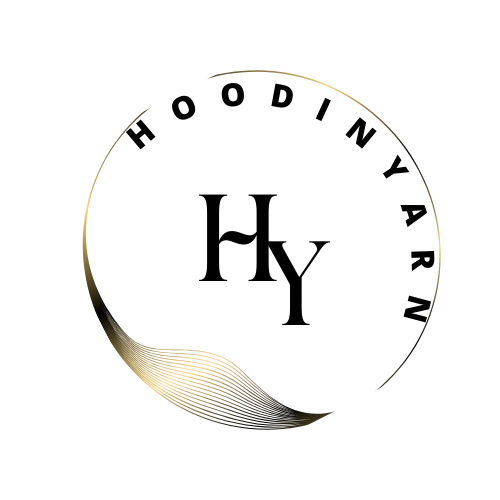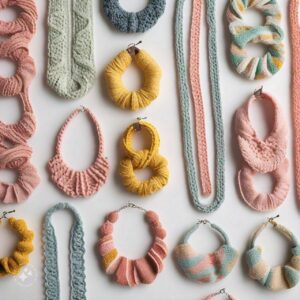
Knowing the many types of yarn is essential for anybody who works with yarn, as it is the basis of both knitting and crocheting. Because each type of yarn has distinct qualities of its own, it may be used for different kinds of projects and purposes. This guide offers a thorough examination of several yarn kinds, their characteristics, and the ideal applications for each.
Types Of Yarn
1. Wool Yarn

Features:
- natural fiber derived from sheep’s fleece.
- renowned for being flexible, warm, and long-lasting.
- offered in a range of grades, weights, and textures.
- Depending on the type of wool, it can be either soft or scratchy.
Applications:
- Winter Apparel: Wool is perfect for creating cozy knit or crochet items such as mittens, scarves, caps, and sweaters. Its insulating qualities aid in the retention of body heat.
- Felting: Wool works beautifully for felting projects such as slippers, purses, and home décor items because of its inherent ability to shrink and bond together when exposed to heat and moisture.
- Throws and Blankets: Wool is a great material for warm throws and blankets because of its resilience and warmth.
Types Of Wool
- Merino Wool: Perfect for clothing worn adjacent to the skin, Merino Wool is soft, fine, and less irritating. Its opulent vibe makes it extremely valuable.
- Shetland Wool: Sturdier and coarser, perfect for clothing and other things that must endure heavy use.
- Cashmere: Expensive, but incredibly soft and opulent. Ideal for unique things such as shawls and scarves.
- Lambswool: Derived from a young sheep’s first shearing, this soft material is perfect for fine clothing.
2. Cotton Yarn

Features:
- organic material obtained from the cotton plant.
- robust, absorbent, and breathable.
- less elastic than wool, which may have an impact on the finished product’s fit and drape.
- It’s soft and cozy, perfect for wearing in warm weather.
Applications:
- Summer Apparel: Lightweight, breathable items such as cardigans, skirts, and tops are ideal for cotton yarn.
- Home décor: It works well for products like dishcloths, towels, placemats, and market bags because of its strength and washability.
- Baby Products: Cotton is a great material for toys, blankets, and outfits for babies since it is soft and kind to the skin.
Types Of Cotton
- Mercerized cotton is strengthened and given a glossy, smooth texture. Perfect for tasks that call for a more refined appearance.
- Organic cotton is a sensitive skin-friendly, environmentally friendly choice that is grown without the use of artificial chemicals or pesticides.
- Pima Cotton: A superior grade of cotton with longer fibers that makes for a softer and more resilient yarn.
3. Acrylic Yarn

Features:
- synthetic material consisting of polyacrylonitrile.
- Reasonably priced, broadly accessible, and adaptable.
- Easy to maintain and hypoallergenic, frequently machine washing and dryingable.
- has a wide variety of hues and textures.
Applications:
- Everyday Wearables: Acrylic works well for a variety of apparel items, especially for people on a budget. These include mittens, scarves, caps, and sweaters.
- Home Decor: Because of its longevity and low maintenance requirements, it’s perfect for blankets, cushions, and other home accents.
- Toys and Amigurumi: It’s ideal for making plush toys and amigurumi due to its variety of colors and price.
Types of Acrylic:
- Blended acrylic: To improve its properties without sacrificing price, it’s frequently combined with natural fibers like cotton or wool.
- Superior Acrylic: Superior acrylic that is more resilient, supple, and less prone to pilling compared to standard acrylic yarns.
4. Silk Yarn

Features:
- natural fiber that silkworms generate.
- opulent, glossy, silky, and draped beautifully.
- light-weight but robust and long-lasting.
- provides exceptional temperature control, keeping you cool in the summer and warm in the winter.
Applications:
- Stylish Clothes: Ideal for elegant ensembles like as scarves, shawls, and flowy blouses that take use of its sheen and drape.
- things for Special events: Silk is perfect for things intended for gifts or special events because of its opulent appearance.
- Accessory: Enhances the elegance of items such as hats, gloves, and handbags.
Types Of Silk:
- The most popular and premium type of silk is mulberry silk, which is prized for its strength and even texture.
- Tussah Silk: This type of silk is less consistent and has a more rustic, textured appearance. It is made from wild silkworms.
- Spun Silk: Originating from shorter fibers left over from the manufacturing process, resulting in a yarn that is softer but less lustrous than filament silk.
5. Alpaca Yarn

Features:
- Alpaca fiber that is natural.
- Silky texture; warmer and softer than wool.
- Due to the absence of lanolin, it is hypoallergenic and lightweight compared to sheep’s wool.
- robust, long-lasting, and exquisitely draped.
Applications:
- Warm Clothes: Perfect for making warm mittens, scarves, caps, and sweaters using yarn or crochet; offers excellent warmth without being bulky.
- Baby Items: Because of its hypoallergenic qualities, it is appropriate for use in blankets, outfits, and accessories for babies.
- Luxurious goods: Alpaca’s softness and drape make it ideal for shawls, wraps, and throws, among other opulent goods.
Alpaca Types:
- Huacaya Alpaca: Excellent insulation; fluffy and crimpy, akin to sheep’s wool.
- Suri Alpaca: Perfect for dressy clothes and accessories, its smooth, straight fiber has a lovely drape.
6. Bamboo Yarn

Features:
- fiber that is naturally generated from bamboo plants.
- It feels cool and is airy, smooth, and soft.
- biodegradable and benign to the environment.
- possesses a lovely drape and shine.
Applications:
- Summer Apparel: Lightweight and airy items such as cardigans, dresses, and tops are ideal for bamboo yarn.
- Baby Items: It’s perfect for baby blankets, outfits, and accessories because of its breathability and tenderness.
- Delicate Projects: Enhances the elegance of delicate pieces such as lightweight wraps, scarves, and shawls.
Types Of Bamboo:
- Pure Bamboo: Ideal for elegant applications, it has a lovely luster and drape.
- Bamboo Blends: To provide bamboo strength and durability without sacrificing its smooth, soft texture, bamboo is frequently blended with cotton or wool.
7. Linen Yarn

Features:
- cellulose derived from flax plants.
- robust, long-lasting, and softens with every washing.
- smooth smoothness with a hint of luster.
- Warm weather-friendly because it is absorbent and breathable.
Applications:
- Lightweight Clothing: Breathable and comfortable, ideal for summer attire such as dresses, skirts, and shirts.
- Home décor: Because of its strength and durability, it’s perfect for things like tablecloths, table runners, and drapes.
- Accessories: Gives items like hats, belts, and purses a refined touch.
Types of Linen:
- Pure Linen: Sturdy and robust, ideal for lengthy undertakings.
- Blends of linen: When combined with cotton or other fibers, linen retains its resilience but gains softness and elasticity.
8. Blended Yarn

Features:
- blending of two or more distinct fiber types.
- created to incorporate each fiber’s best features.
- adaptable and frequently less expensive.
Applications:
- Numerous Projects: Blended yarns can be used for a wide range of projects, including clothes, accessories, and home decor, depending on the blend.
- Enhanced Qualities: Blends frequently combine the softness of cotton with the shine of silk, or the warmth of wool with the affordability of acrylic.
Types Of Blended Yarn:
- Blends of wool and acrylic: Warm and reasonably priced, ideal for staple items like caps and sweaters.
- Blends of cotton and bamboo are soft, breathable, and eco-friendly; they work well for summer clothing and baby products.
- Blends of silk and wool are ideal for sophisticated clothing and accessories because they combine the plush feel of silk with the warmth and suppleness of wool.
Conclusion:
Selecting the appropriate yarn for your project requires taking into account each type’s qualities and how they align with the results you hope to achieve. Whether you’re making sturdy home decor, breezy summer clothing, or warm winter attire, knowing the qualities and applications of various yarns can help you get the finest results. Every kind of yarn has special properties to offer, so you may customize any craft to exactly fit your preferences and demands. There are many other types of yarns.
Related Article
Right type of knitting niddles




Pingback: Yarns Magic: 8 Best Ideas for Leftover Yarn
Pingback: Crocheting Dress of Lord Krishna In 4 Easy Steps